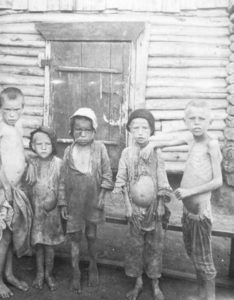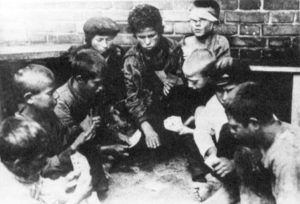“Bezprizorniki” [pronounced: Byez-pree-zor-nee-kee]
“Those Who Are Uncared For.”
“Those Who Are Uncared For.”
Many have been asking “Why?” concerning the epidemic of the street children in Russia and we have been trying to answer that question for you.

Starving Russian Children at Red Cross Hospital 1920
Looking at the history of Russia we discovered that the epidemic of street children has been ongoing for quite some time.
Throughout the 1920’s and 1930’s the Soviets built the country into a world industrial power. Unfortunately, this cost millions of Soviet citizens their lives. Famine, genocide, deportations, and the creation of a massive prison system (called the Gulag) created the plight of the
homeless children.
Alexander Ananin writes in his 1999 article, Homeless Children in Russia, Clad in filthy, lice-infested rags and staggering from exhaustion and hunger, they began to appear on the streets of Moscow by late summer of 1921, whole armies of children-grimy, starving vagrants-jammed train stations, docks, and bazaars.’
From Rostov-on-the-Don, a journalist reported, “Parents regularly stranded dependents in the large square outside a train station, telling them to wait there just a minute until they returned from some minor undertaking. As time passed and the parents did not reappear, children around the square began to wail helplessly. Rarely did anyone respond to their grief, merely a drop in a sea of misery.”
“During the 1920s children could be seen in every city as beggars, thieves and prostitutes in abandoned buildings, train stations and flophouses, sleeping in the frigid winters by bunching together on the sidewalk, pressed tightly together, like ‘a nest of shivering mice.’”
Reports are that between 1920 and 1940 the number of children living on the street were in the range of seven and nine million. It is almost too much to comprehend!

Russian Street Children 1940
Micaiah Ministries has visited orphanages that were set in place during this time period, orphanages that have had no repairs since 1961 and no hot water for more than thirty years. As a rule, state orphanages were vastly overcrowded, dirty, and understaffed. These facilities were down right scary. Although many of the staff cared for the children and wrote desperate letters requesting help, funding was limited. Many of the children, frightened, would run away, back to the streets. Orphanages are receiving attention once again from the government and many upgrades have been made.
Almost immediately after the fall of communism, there began a period of severe economic instability when currencies collapsed. A majority of the population became impoverished and more than 75 million people fell into poverty from 1989 through the mid-1990’s; wages dipped for most people to less than 50 percent of their previous earnings. In 1998 alone, during a currency crisis, 20 million Russians fell into poverty.
The Soviet State had employed most of the population. Factories closed, unemployment soared, and manyfamilies suffered. Parents, under the stress of no jobs or of working longer harder hours and multiple jobs to make ends meet, instead of turning to Christ, turned to alcohol and drugs. Many turned to other methods of making money. Sadly, child trafficking was discovered to be a new method of making money.

Vadik, Andre, Zhenya, Katia, Katia, Sergei and Dima 1994
During our first visit to Saint Petersburg in 1994, many children could be found on the streets, in the Metro and at the railway begging for money. Two such children from a feeding center that we visited and supported were adopted by one of their staff, and as adults were at one time part of the team at Micaiah Ministries Restoration House. Sergei and Olya who are now directors at Restoration House also spent many years of their youth and into young adult life on the streets.
An August 2007 report published by the Associate Press in newspapers around the world included statistics that tell us around 2,000 children seventeen years old and younger are murdered every year by abusive relatives. According to a UNICEF report, the rate for suicide in Russian youth ages 15-19 is 20.2 per 100,000 in 2004. (Nearly 6,000 children in that age bracket every year.) Child’s Right, citing state statistics, says about 50,000 Russian children run away from home every year and another 20,000 flee from state run orphanages and other institutions.
According to U.N. reports from 2012 (Orphanage teachers tell us that not much has changed since the report of 2012) 90% of young people who age out of the orphanages between the ages of 16-18 end up on the street, in prison, prostitution, doing drugs, and drinking alcohol. One more recent statistic that has changed was reported in a local newspaper from Gatchina, Russia. Suicide is on the rise among these young people. It is now reported that 10% commit suicide within the first year of aging out of the orphanages.
.
We cannot overstate the importance of Restoration House and the vision.